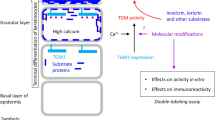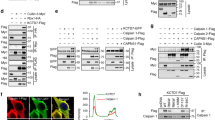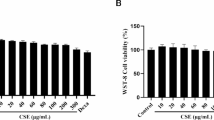Abstract
Calpain I (μ-calpain) and II (m-calpain) are well known calcium-activated neutral cysteine proteases. Many reports have shown that activation of calpain is related to cataract formation, neuronal degeneration, blood clotting, ischemic injuries, muscular dystrophy and cornified cell envelope (CE) formation. Here, we report that insoluble CE formation was reduced after treatment with calpain I inhibitor (N-acetyl-leucyl-leucyl-norleucinal) on normal human epidermal keratinocytes (NHEK), whereas serine and thiol protease inhibitors had no effect on the reduction of CE. When NHEK cells were confluent, keratinocytes were treated with various concentrations (0.5 µM-0.5 mM) of calpain I inhibitor or serine and thiol protease inhibitors under calcium induced differentiation. Insoluble CE formation was reduced about 90% in the 50 µM calpain inhibitor I treated group by day 9 of culture, whereas insoluble CE was reduced only 10% in the same condition. Interestingly TGase activity was blocked by 90% in the 0.5 mM calpain inhibitor treated group within 72 h, whereas TGase activity was retained by 80% in the 0.5 mM serine protease inhibitor treated group at 7 day treatment. Therefore it can be suggested that cysteine protease calpains might be responsible for the activation of the TGase 1 enzyme to complete insoluble CE formation during epidermal differentiation.
Similar content being viewed by others
Article PDF
Author information
Authors and Affiliations
Rights and permissions
This is an Open Access article distributed under the terms of the Creative Commons Attribution Non-Commercial License (http://creativecommons.org/licenses/by-nc/3.0/) which permits unrestricted non-commercial use, distribution, and reproduction in any medium, provided the original work is properly cited.
About this article
Cite this article
Kim, SY., Bae, CD. Calpain inhibitors reduce the cornified cell envelope formation by inhibiting proteolytic processing of transglutaminase 1. Exp Mol Med 30, 257–262 (1998). https://doi.org/10.1038/emm.1998.38
Published:
Issue date:
DOI: https://doi.org/10.1038/emm.1998.38
Keywords
This article is cited by
-
Cornification of keratinocytes is associated with differential changes in the catalytic activity and the immunoreactivity of transglutaminase-1
Scientific Reports (2023)
-
Role of syntaxin3 an apical polarity protein in poorly polarized keratinocytes: regulation of asymmetric barrier formations in the skin epidermis
Cell and Tissue Research (2023)
-
iTRAQ-based quantitative proteomics of stratum corneum of dandruff scalp reveals new insights into its aetiology and similarities with atopic dermatitis
Archives of Dermatological Research (2016)
-
Topical Antihistamines Display Potent Anti-Inflammatory Activity Linked in Part to Enhanced Permeability Barrier Function
Journal of Investigative Dermatology (2013)
-
Death penalty for keratinocytes: apoptosis versus cornification
Cell Death & Differentiation (2005)



